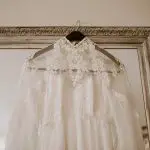Organza fabric is quite the showstopper—it's sheer and lightweight, so if you hold it up, you can see right through it. It's got this wonderful crisp feel that rustles when you move. Its stiffness is what lets it keep a definite shape, making it perfect for wedding dress overlays or fancy evening wear accents. Organza also has a bit of a shine, so it catches the light beautifully. You'll find it made from silk, nylon, or polyester, each adding its own touch to the fabric's texture and look. There's so much more to explore about how organza can elevate different styles.
Table of Contents
Key Takeaways
- Organza fabric is sheer, allowing light to pass through and giving it a see-through quality.
- It features a slight shine that elegantly catches and reflects light.
- Known for its stiffness, organza can hold structured shapes like voluminous skirts.
- Organza has a crisp texture that rustles when moved.
- Available in various types such as silk, polyester, and nylon, each adding unique textural qualities.
Defining Organza Fabric
Organza fabric is a sheer, lightweight material that often adds a touch of elegance to evening wear and decorations. You've probably seen it in flowy evening gowns, as overlays on skirts, or even as sashes and ribbons in home décor. What makes organza unique is its crisp texture, which isn't just about how it feels but also how beautifully it holds shapes. Imagine a wedding dress with a voluminous organza skirt – it's almost like wearing a cloud!
The fabric's slight stiffness comes from the way it's made, typically using silk, polyester, or nylon fibers. This stiffness allows designers to create breathtaking structures and silhouettes that softer fabrics couldn't achieve. If you're into DIY projects, you might've used organza for making decorative flowers, bows, or even festive garlands. Its ability to maintain form while being light as a feather makes it a favorite for crafting intricate details.
Despite its delicate appearance, organza is quite durable. It's not something that'll tear easily, which is why it's a go-to for items that need to look pristine over time, like bridal wear. It's a fabric that combines beauty with resilience, making it a staple in both fashion and decoration realms.
The Origin of Organza
Where did the elegant organza fabric originally come from? Well, it's quite a journey back in time and across different cultures. I'm fascinated by how textiles tell the story of human civilization, and organza is no exception. This sheer, lightweight fabric actually has its roots in the East, making its way into Western fashion much later.
Organza was first woven in traditional silk hubs in the Middle East and Asia, particularly in regions that are now part of modern-day China and India. These areas were well-known for their mastery in silk production, which is essential for creating authentic organza. Here's a quick rundown:
- Silk Road Contribution: Organza likely traveled via the Silk Road, enriching its value and variety as it passed through various cultures.
- Royal Courts: It became a staple in the royal courts of Asia, symbolizing wealth and status.
- European Adoption: By the 18th century, organza found its way into European fashion, becoming a popular choice for the aristocracy's evening and bridal wear.
Key Characteristics
Let's dive into what makes organza such a unique fabric. First off, it's sheer, which means it has a kind of see-through quality. Think of it like the fabric equivalent of a fine mesh screen. This sheer nature gives it a delicate and lightweight feel, ideal for those floaty, fairy-tale layers in gowns.
Another big characteristic is its stiffness. Unlike some other fabrics that drape and flow, organza holds its shape. This can add a crispness to clothing that's hard to achieve with softer materials. Imagine a wedding dress with a voluminous skirt that seems to float as the bride walks down the aisle—that's organza at work.
It's also worth mentioning that organza has a slight shine. Not outright glossy, but with a subtle shimmer that catches the light beautifully. This makes it a favorite for evening wear and other garments where you want a touch of elegance without full-on sparkle.
Varieties of Organza
Diving into the different types, you'll find that organza comes in several varieties, each with its unique appeal. It's fascinating how this fabric can vary so much based on its material and the process used to create it. Let's explore the main types:
- Silk Organza
Made from silk, this traditional type of organza is the epitome of luxury. It's incredibly smooth and has a subtle sheen that catches the light beautifully. Think of those breathtaking wedding dresses or high-fashion evening gowns — that's silk organza in action.
- Polyester Organza
More affordable and durable than silk, polyester organza is a popular choice for decorative purposes. It's commonly used in making festive decorations, like those fancy ribbons and bows you see in party stores or dressing up tables at a gala.
- Nylon Organza
Similar to polyester but with a slightly stiffer texture, nylon organza holds shapes well, making it ideal for crafting voluminous skirts and costumes. It's the go-to material for anyone wanting to add a bit of drama to their outfit without the hefty price tag.
Each type serves distinct purposes, and choosing the right one really depends on your specific needs and budget.
Textural Qualities
When I first touched organza, I was struck by how sheer it is; you can almost see right through it!
It's incredibly lightweight, making it feel almost like you're holding nothing at all.
Plus, there's this distinctive crispness to it that you can't miss — it rustles with every move you make.
Sheer, Lightweight Feel
Organza fabric, with its sheer and lightweight feel, seems almost like a whisper against the skin. It's like wearing air, if you could. When I first touched organza, I was amazed by its delicate nature. Despite its lightness, it holds its shape well, making it a favorite for creating volume without the weight in garments like evening gowns and wedding dresses.
Here are three key aspects to appreciate about organza's texture:
- Airiness: It's so light that it floats around you, barely noticeable.
- Softness: Despite its structured look, organza feels soft to the touch.
- Breathability: Perfect for warm weather outfits, it allows your skin to breathe easily, avoiding that sticky feeling lesser fabrics might give.
Distinctive Crispness
Beyond its delicate softness, organza has a distinctive crispness that adds a unique texture to any outfit. It's like when you choose a fresh, crisp apple from the market—there's something immensely satisfying about that first crunchy bite. Organza gives that same kind of satisfaction when you wear it.
The fabric isn't just soft to the touch; it holds its shape, creating structure and volume that make your clothes pop. Think of a ball gown's billowing skirt or a sharply tailored high-fashion top. That crispness is crucial; it transforms what could be just another piece into something truly eye-catching.
It's this characteristic that makes organza a favorite for designers aiming to make a bold statement.
Color and Sheen
Moving on to color and sheen, organza really shines when it comes to the variety of hues and its reflective glossiness.
You can find it in just about any color you can think of, from soft pastels to vibrant primaries.
The fabric's light-catching sheen adds a touch of glamour, making it a favorite for evening wear and decorations.
Variety of Hues
Diving into its visual appeal, organza offers a stunning array of colors and a unique sheen that catches the eye. From vibrant neons that make your party dresses pop to soft pastels perfect for spring weddings, the versatility of organza's color palette is unmatched. Here's how its colors play a crucial role:
- Depth and Dimension: The varying shades can add depth to any outfit, making a simple design look intricate.
- Mood Setting: Color choice in organza can set the tone of an event. Imagine the difference between bold reds and calming blues!
- Seasonal Adaptability: Light hues for spring and darker tones for winter; organza's variety supports year-round fashion needs.
Each hue brings its own story to your ensemble, truly enhancing the fabric's charm.
Reflective Glossiness
When you catch organza in the light, its reflective glossiness creates a dazzling effect that can transform any look. This sheen isn't just shiny; it's sophisticated and can vary from subtle to striking depending on the angle of the light.
Picture a bridesmaid's dress at an outdoor wedding, sparkling gently in the sunlight, or imagine a ballet skirt catching the stage lights with every twirl. That's organza for you. It's all about the fabric's ability to reflect light, which adds depth and dimension to colors.
Whether it's a deep blue or a soft pink, the glossiness enhances every shade, making organza a favorite for designers looking to add a touch of glamour without overpowering the garment's design.
Common Uses in Fashion
Organza fabric is a staple in creating voluminous skirts and evening gowns. It's the go-to material when you want that fairy-tale kind of silhouette without the heaviness you might get from other fabrics. What's great about organza is its versatility in fashion design. It's not just for big moments on the red carpet; it finds its way into everyday wear too, adding a touch of elegance that's hard to match.
Here's why organza is such a favorite:
- Bridal Wear: It's almost a given that organza will show up in bridal fashion. Its sheer, lightweight nature gives a bridal gown that ethereal look, making it perfect for overlays, sleeves, and detailed trains. The stiffness of high-quality organza also helps in creating dramatic, stand-out silhouettes that many brides dream of.
- Fashion Accents: Organza isn't limited to the main parts of an outfit. It's often used for adding detailed touches like ruffles, bows, and floral embellishments that make a garment pop. These accents are perfect for those who want to add a bit of drama without overwhelming the entire look.
- High Fashion: On the runways, organza brings fantasy to life. Designers love it for its ability to form sculptural shapes and its translucent quality that plays with the light beautifully. Whether it's avant-garde pieces or mores, organza provides that delicate balance between structure and flow.
Organza in Home Décor
Beyond fashion, I've found that organza also adds a touch of sophistication to home décor, particularly in curtain designs and decorative accents. When you hang organza curtains, they let in just the right amount of light, creating a soft, diffused look that can really brighten up a room. It's not just about looking good during the day, either. At night, these curtains have a subtle shimmer that adds an elegant vibe to any space.
I've also used organza as a runner on my dining room table. It's a simple way to upscale an ordinary table setting, especially when I'm hosting guests. The sheer texture of organza layered over a solid tablecloth creates a depth that's both visually appealing and conversation-starting.
In my living room, organza throw pillows are my go-to for a quick style refresh. They're light, airy, and they add a splash of elegance without being too overstated. I prefer neutral shades that blend seamlessly with my existing decor, enhancing without overwhelming.
Caring for Organza
While I love using organza for its elegance, keeping it looking its best requires some specific care tips. Organza's delicate nature means it can be a bit tricky to handle, but don't worry, I've got you covered with some straightforward advice that'll keep your organza items looking as lovely as the day you bought them.
Here are three key tips:
- Gentle Washing
Always opt for hand washing organza with mild detergent in cold water. Avoid twisting or wringing it out; instead, gently squeeze the water out. Trust me, your fabric will thank you by staying crisp and beautiful.
- Proper Drying
Never throw organza in the dryer! Always air dry it by laying it flat on a clean towel. This prevents any shape distortion and keeps the fibers intact. It might take a bit longer, but the results are worth the wait.
- Ironing Care
Iron organza while it's still slightly damp, and use a low heat setting. Place a pressing cloth between the iron and the organza to avoid direct contact, which can cause scorching. This extra step helps maintain that pristine, wrinkle-free look.
Adhering to these care tips ensures your organza remains impeccable, reflecting mastery in maintaining its delicate charm and luxurious appeal.
Frequently Asked Questions
Can Organza Fabric Cause Allergic Reactions?
Interestingly, I've found that while organza fabric is stunning, it can indeed cause allergic reactions, especially if you're sensitive to certain textiles. It's worth checking the material blend before making a purchase.
Is Organza Suitable for Winter Clothing?
I wouldn't recommend organza for winter clothing; it's too sheer and lightweight. You'd need something thicker to keep warm, like wool or fleece, especially during those chilly winter months.
How Does Organza Impact the Environment?
Organza's eco-footprint is like a double-edged sword; it's beautiful but can be harmful. Derived from silk, its production is energy-intensive and often involves chemicals, impacting our planet more than we'd like.
Are There Vegan Alternatives to Silk Organza?
I've found that vegan alternatives to silk organza, like nylon or polyester organza, offer similar sheerness and stiffness, making them great for fashion without using animal products. They're also often more affordable.
Can Organza Be Dyed at Home?
Yes, I've dyed organza at home using fabric dyes—you just need to ensure the dye is suitable for the fabric type. It's quite a fun project if you follow the instructions carefully!
- Tetron Fabric for Marine Applications: Durability and Use Cases - June 18, 2025
- Tetron Fabric for Outdoor Furniture: Weather Resistance and Care - June 18, 2025
- Tetron Fabric for Wall Coverings: Style and Application Tips - June 18, 2025





